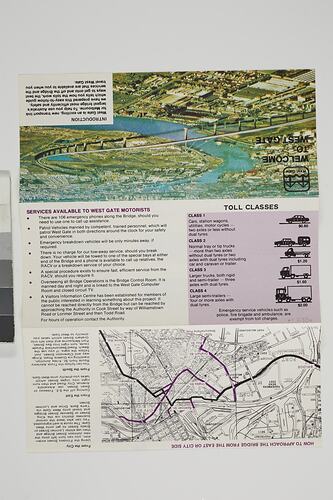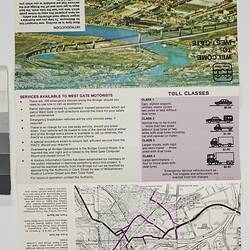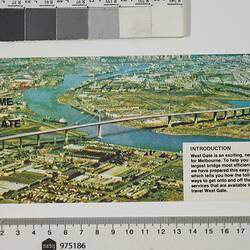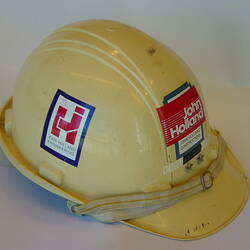Summary
Publicity brochure produced by the West Gate Bridge Authority to promote the completion of the West Gate Bridge and provide information to motorists about tolls, access routes, facts & figures about the bridge and other operation features such as emergency phones and closed circuit television monitoring of bridge operations.
The West Gate Bridge Project saw the construction of a 2.5 km high-level road bridge across the lower Yarra River from Port Melbourne to Spotswood. Construction commenced under the Lower Yarra Crossing Construction Authority in 1965 and was completed in 1978. The name of the authority was changed to the West Gate Bridge Authority in September 1974.
Published by the West Gate Bridge Authority, PO Box 127, Port Melbourne, Victoria, Austalia, 3207.
Two copies of this leaflet were sent to Mr & Mr E. Cobb together with passes for the bridge opening and instructions relating to the Transport Cavalcade in which they participated for the bridge opening on 15 November 1978.
Physical Description
DL-sized folded information leaflet printed in full colour on cover and two colours (black & violet) on remainder (2 copies). Features an aerial view of the completed West Gate Bridge on the cover.
Significance
This small collection of ephemera provides an insight into the organisation and order of proceedings for the Opening Ceremony held on 15 November 1978 to mark the much anticipated completion of Melbourne's West Gate Bridge. The items were retained as souvenirs by Mr E. Cobb, who participated in a Transport Cavalcade of 28 vintage, veteran and contemporary motor vehicles that crossed the bridge in a procession just prior to the formal opening ceremony. Mr E. Cobb (accompanied by his wife) drove a restored 1914 French-built La Buire motor car with open two-seater body in the parade which began at Flinders Street Station then drove to Spotswood before proceeding from west to east across the bridge. Other vehicles included in the cavalcade were Ted Pritchard's experimental steam car built from a converted 1963 Ford Falcon and the Melbourne designed and built prototype Ilinga luxury sports coupe (ST 039661) that is now held in the Museum Victoria collections.
Built between 1968 and 1978, the Westgate Bridge has become an integral part of Melbourne's freeway network and a vital east-west transport link connecting Melbourne's western suburbs and the Princes Freeway route to Geelong and beyond to the centre of Melbourne. Designed to replace the Williamstown Ferry that had operated across the lower Yarra between Fisherman's Bend and Newport since 1931, it was constructed by the Lower Yarra Crossing Authority and initialled opened as a tollway - the first 'user pays' road in Melbourne for over a century.
Since it first began to rise above the mudflats of the lower Yarra, the West Gate Bridge has become a key local landmark which Melburnians quickly took to heart and it remains the city's best recognised international engineering landmark. Towering high above the river flats with its sweeping approach spans and 102-metre high twin cable-stay towers, it is Victoria's highest and second-longest bridge, with an overall length of 2,582 metres, including approach spans. Its innovative design was of international significance, at the time, with the world's longest cable-stayed steel girder span.
On 15 October 1970, the West Gate Bridge made international headlines when at 11.50 am the partially completed 367-ft (112 m) box girder span between piers 10 and 11 collapsed. In a matter of seconds 2,000 tonnes of steel and concrete crashed 50 metres onto the river mudflats bringing down two of the bridge piers and killing 35 workers, with 18 others seriously injured. The disaster remains Australia's worst industrial accident in terms of lives lost and became a pivotal moment in Melbourne's post-war history.
Following design alterations construction of the West Gate Bridge was finally completed in 1978 at a cost of $202 million - over eight times the original estimate. While Sydney-siders had become used to paying tolls for decades to cross their Harbour Bridge, the tolls initially charged on all private & commercial vehicles (60c for cars & $2 for trucks) crossing the West Gate Bridge were unpopular with Melburnians and after just six years were abolished early in the first term of Cain Labor Government. By mid 1979, the bridge was carrying 22,000 vehicles/day. By 2008 the bridge had exceeded its designed daily capacity and strengthening works were scheduled to be undertaken between 2008 and 2011.
(Item 9) The leaflet flyer relates to the advertising campaign run by Melbourne radio station 3DB at the time of the opening. A separate acquisition proposal covers bumper stickers distributed to motorists as part of the campaign. Radio station 3DB broadcast on the AM band in Melbourne between 1925 and 1988 when it became 3TT and then TTFM following a change to FM broadcasting in 1990.
More Information
-
Collection Names
-
Collecting Areas
-
Acquisition Information
Purchase
-
Issued By
-
Inscriptions
Text, printed: WELCOME/TO/WEST GATE/INTRODUCTION/West Gate is an exciting, new transport link/for Melbourne. To help you use Australia's/largest bridge most efficiently and safely,/we have prepared this easy-to-follow guide/which tells you how the tolls work, the best/ways to fet onto and off the Bridge and the/services that are available to you when you/travel West Gate.
-
Classification
-
Category
-
Discipline
-
Type of item
-
Overall Dimensions
214 mm (Width), 92 mm (Height)
-
References
Hitchings, Bill, 'West Gate', Collingwood, Vic: Outback Press, 1979.
-
Keywords



